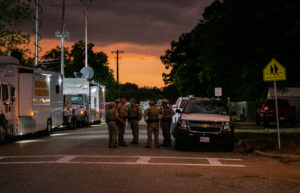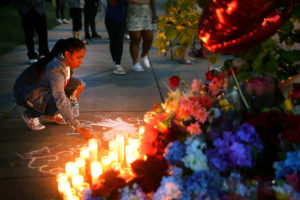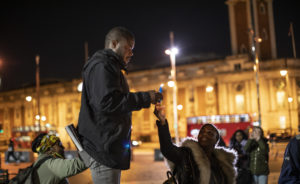Rampage shooters tend to be losers. The archetype of the modern school shooter, Eric Harris, frequently wrote in his diary about his feelings of alienation and resentment over his lack of social success. “I just want to be surrounded by the flesh of a woman,” begins an entry dated five months before the Columbine shooting, which later devolved into psychopathic fantasies of torture and mutilation. But in an entry from five days later, written after purchasing his first guns, Harris is exuberant. “I am fucking armed. I feel more confident, stronger, more God-like.”
Elliot Rodger, the 2014 Isla Vista shooter whose “manifesto” was a laundry list of complaints about his loneliness and sexual rejection, felt particularly resentful toward his female classmates, whom he saw as “mean, cruel, and heartless creatures that took pleasure from my suffering”. Unable to attract a girlfriend, he settled on revenge. “If I cannot rise above them,” he wrote, “I will destroy them.” When Rodger finally buys a handgun, he is happy for the first time since childhood. “I brought it back to my room and felt a new sense of power. I was now armed. Who’s the alpha male now, bitches?”
We don’t know yet what motivated Salvador Ramos, the teenage gunman who killed 21 people in Uvalde, Texas, last week, but we do know that like most shooters, he was a misfit and social outcast. Early reporting suggests that he spent recent months harassing teen girls on social media, “repeating girls’ names until they paid attention to him”, and expressing to them his desire to get his “name out there” like the Canadian murderer Luka Rocco Magnotta. The Buffalo shooter, Payton Gendron, was also an oddball with a history of making threats, although his immediate motives seem to have been more ideological than social or sexual. Even so, in the course of his white supremacist diatribe, he blamed “weak” “European men” for the degeneracy of the West and concluded that “strong men are needed to fix it”.
Whatever the nominal motivations behind them, rampage shootings are nearly always a product of wounded masculinity. “They are the most masculine of crimes,” says Ralph Larkin, a criminologist at John Jay College who has studied mass shootings for decades. “Can you think of more than four or five female mass shooters? There aren’t any.” Shooters, Larkin says, are “marginal males who feel they have been wronged by society, and so they pick up a gun. There is always a sense of violated entitlement, and I don’t care whether it’s school shootings or racist shootings.”
Modern mass shootings, according to Larkin, began in 1966, when Charles Whitman, a former Marine with an undiagnosed brain tumour, murdered his wife and mother before climbing to the top of a tower in downtown Austin, Texas, and shooting 14 people to death. Larkin speculates that the sudden rise in these shootings was a reaction to the sexual liberation of the Sixties and the corresponding rise in the status of women — a point on which some of the more historically minded murderers would no doubt agree. “We’re talking about toxic masculinity here.”
Toxic masculinity, of course, is a somewhat slippery concept. Colloquially, it refers to the elements of traditional masculinity — competition, stoicism, aggressiveness, physical strength, a willingness to resort to violence — that fit awkwardly or not at all into modern liberal culture. A 2019 explainer in the New York Times defined it as “a set of behaviours and beliefs” that men are socialised into from a young age, including “suppressing emotions or masking distress”, “maintaining an appearance of hardness”, and “violence as an indicator of power”. More than a few articles have flagged toxic masculinity, combined with Americans’ easy access to guns, as one of the causes of mass shootings.
These elements of masculinity can no doubt be “toxic” in the wrong circumstances — the problem is with the assumption that they are purely a product of cultural scripts, rather than reflections of something inherent in men. Francis McAndrew, a psychologist who has studied mass shootings, told me that while socialisation plays a role in encouraging some forms of male violence, it does not create it out of thin air. This is particularly true for young men, who are ultra-sensitive to status competition, which historically would have determined their ability to attract women and form alliances with other men. Young men, McAndrew says, have been selected to regard adolescent social hierarchies as a matter of life and death.
“Today, you can go to college or move to a new city,” McAndrew says. “But when we were evolving, whatever happened during adolescence was a life sentence. And if you established yourself as a bad dude that nobody messed with, that could work to your advantage. Our minds are still stuck in that past of needing to be paid attention to. And the guys who don’t get that experience all kinds of dark emotions. They feel left out, they feel like losers, they feel desperate, and they need to make a statement.”
For these alienated young men, guns and violence can be intoxicating. According to the “challenge hypothesis”, male testosterone and aggressive behaviour surge in response to “situational cues that represent either a threat to a male’s status or a signal that competition with other males is imminent”. Handling a gun acts as one such cue, especially for men who are not used to them. “If you pick a powerful weapon and you perceive that combat is imminent, you get a spike in your testosterone levels,” McAndrew says. Given that marginal males tend to have low testosterone, which can lead to feelings of anxiety and depression, this spike can be euphoric, as shooters like Harris and Rodger attest. “The solution,” McAndrew says, half-joking, “is that everyone should be allowed to own high-powered weapons except for men under the age of 40.”
Mass killings are also, themselves, a way to achieve status and notoriety. McAndrew notes that for ideological spree killings, like the Buffalo shooting or jihadist attacks, the ideology “organises and channels” the killers’ rage, providing them with a community, an audience, and a sense that they are contributing to some important cause — in other words, status and a measure of celebrity for people who feel they are invisible. And status and celebrity, even of the worst kind, have their benefits. According to a 2018 story from the Florida Sun-Sentinel, Nikolas Cruz, the far-Right loner who murdered 17 people at Marjory Stoneman Douglas High School, was inundated with fan mail from female admirers after being arrested for his killing spree.
This should not come as too great of a shock. According to the sociologist Nathalie Paton, rampage shootings represent a perverse expression of some of our culture’s dominant values, including self-expression, autonomy, and authenticity. “Nowadays the social norm is to ask each and every person to pursue individuation, to become autonomous,” she says. “But it’s a paradox — when you ask everyone to be original not everyone can be, so they have to go to extremes like violence. It becomes a form of empowerment, a way to pull away from social norms that are imposed.” As she wrote in an article from 2017: “The very project of a mass shooting not only allows the reversal of social roles, but ultimately it becomes the guarantee of subjective liberation.”
The shooters, Paton argues, highlight another contradiction in the dominant ideology. Everyone is supposed to be an individual, and all individuals are respected equally. Yet beneath this injunction and guarantee are all the typical modes of conformity and hierarchy we would expect of a human society. The beautiful, the talented, the athletic, the funny, and the interesting rise above the ugly, the clumsy, the anxious, the introverted, the boring, and the resentful.
These relative statuses, for the losers, are all the more painful for being nothing other than a reflection of who and what they actually are. “Individuality” is wonderful when your true self is a tall and handsome swimmer with an unexpected love of classical cello, or a beautiful girl who likes to go backpacking with her friends. But who, really, is someone like Salvador Ramos, an odd-looking boy who disturbs nearly everyone he talks to, whose hobbies include shooting people with BB guns and throwing dead cats at strangers’ houses? Does anyone, really, want someone like that to be himself? I doubt it.
In his novel Whatever, in which he first advances his idea that sexual liberalism is a system of social hierarchy no less cruel than economic liberalism — now a cornerstone of “incel” ideology — Michel Houellebecq introduces us to the character of Raphael Tisserand, a man so stupendously ugly that despite his good salary and desperate efforts, he is still a virgin at 28. One evening, after Tisserand has spent hours at a club trying to charm a young women only to see her depart with a handsome black man, Houellebecq’s narrator offers Tisserand a knife and urges him to use it on the couple. “When you feel these women trembling at the end of your knife, and begging for their young lives, then you will truly be the master,” he says. But, after following the pair to the beach, Tisserand is unable to follow through on the murder and decides to drive back to Paris. He dies in a car crash that night.
Our society seems to have its own generation of Tisserands. The problem, in America, is that ours have guns.
Disclaimer
Some of the posts we share are controversial and we do not necessarily agree with them in the whole extend. Sometimes we agree with the content or part of it but we do not agree with the narration or language. Nevertheless we find them somehow interesting, valuable and/or informative or we share them, because we strongly believe in freedom of speech, free press and journalism. We strongly encourage you to have a critical approach to all the content, do your own research and analysis to build your own opinion.
We would be glad to have your feedback.
Source: UnHerd Read the original article here: https://unherd.com




